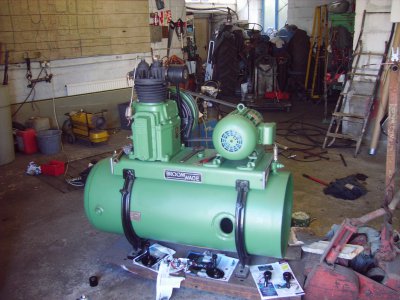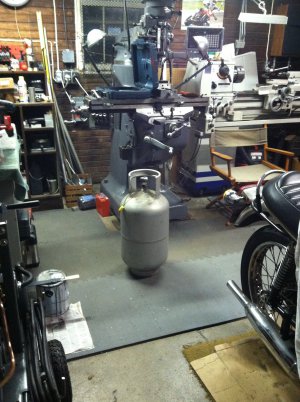-
Welcome back Guest! Did you know you can mentor other members here at H-M? If not, please check out our Relaunch of Hobby Machinist Mentoring Program!
You are using an out of date browser. It may not display this or other websites correctly.
You should upgrade or use an alternative browser.
You should upgrade or use an alternative browser.
Westinghouse Type G2 Refurb
- Thread starter Monk
- Start date
- Joined
- Jun 17, 2012
- Messages
- 65
Monk, I've never heard of an aluminum propane tank. What type of tank is it, and what is it's use? Just curious.
They use them on fork lifts, welders, scissor lifts and other portable equipment....
They look like this: http://www.midsouthliftparts.com/forklift-propane-tank-8-gal-33-5-lb-aluminum/
- Joined
- May 2, 2011
- Messages
- 812
 Here we go again with the old compressor tank failure chestnut, I looked at all those pictures, some of which were stories about compressors that had not failed. All the pictures show clear evidence of massive over-pressure failure caused by faulty pressure switches combined with jammed shut or tampered with safety valves. When a compressor tank rusts through, they will pinhole in the bottom and let the pressure out. Go look at those pictures again, and note the very low levels of internal rust present, indeed, in some there is no rust at all. These catastrophic failures are caused mainly by tanks being made in China from materials that are too thin, and have zero quality control on the materials or the welding or the pressure switches and safety valves. When it comes to compressor tanks, generally the older the better. This is my Compressor pictured while I was refurbing it, it is a 1949 Broom and Wade compressor tank fitted with a BEN Patents 22 cu.ft.min 2 stage compressor. SWP is 150 psi, test pressure is 300 psi (10 bar swp, 20 bar test) The tank is made from 3/8 inch steel sheet!!! I have seen tanks which appeared to be made from 3/16" steel, and this leaves virtually no safety margin for over-pressure, and also means that as they fill with air, they expand, and this work hardens the steel and the welds, which eventually fail, especially if someone "tweaks" the pressure switch to try and get that bit more out of them for sandblasting and other high Cfm applications. By all means pressure check, you can buy a pump like this,
Here we go again with the old compressor tank failure chestnut, I looked at all those pictures, some of which were stories about compressors that had not failed. All the pictures show clear evidence of massive over-pressure failure caused by faulty pressure switches combined with jammed shut or tampered with safety valves. When a compressor tank rusts through, they will pinhole in the bottom and let the pressure out. Go look at those pictures again, and note the very low levels of internal rust present, indeed, in some there is no rust at all. These catastrophic failures are caused mainly by tanks being made in China from materials that are too thin, and have zero quality control on the materials or the welding or the pressure switches and safety valves. When it comes to compressor tanks, generally the older the better. This is my Compressor pictured while I was refurbing it, it is a 1949 Broom and Wade compressor tank fitted with a BEN Patents 22 cu.ft.min 2 stage compressor. SWP is 150 psi, test pressure is 300 psi (10 bar swp, 20 bar test) The tank is made from 3/8 inch steel sheet!!! I have seen tanks which appeared to be made from 3/16" steel, and this leaves virtually no safety margin for over-pressure, and also means that as they fill with air, they expand, and this work hardens the steel and the welds, which eventually fail, especially if someone "tweaks" the pressure switch to try and get that bit more out of them for sandblasting and other high Cfm applications. By all means pressure check, you can buy a pump like this,http://www.ebay.co.uk/itm/RP50-12-L...mp-/291265842360?_trksid=p2141725.m3641.l6368
which will test up to 50 bar (A scary 725 psi) but don't condemn out of hand if it is older, because the newer it is, the worse it will be. The US and the UK used to have standards for the safety and quality of imported equipment, What happened to them? Also beware of Made in the USA/UK, because that probably means made from parts sourced from anywhere in the world that is CHEAP!
Rant over!!
Phil
- Joined
- May 2, 2011
- Messages
- 812
I'll just add that this compressor was my Garage business compressor, and as such was insured and inspected annually by a boiler engineer who used to call me and ask me to empty and open the tank on inspection day. His first report said, "Pitting to a depth of 1/8", his last report said just the same! DRAIN IT WEEKLY!!!
PS, just measured the tank thickness again, my mistake it is actually a massive 5/8" thick plate!
PS, just measured the tank thickness again, my mistake it is actually a massive 5/8" thick plate!
- Joined
- Mar 10, 2012
- Messages
- 125
Again, thank all of you for your input and insight, and Phil that is a great looking refurb on the Broom and Wade . I'm not too worried about mine blowing, since the pressure switch/safety valve is consistently releasing at 120 psi. This unit is HEAVY and solidly built, but obviously, at 40 plus years it should probably be checked out as Eddy suggests. In answer to Jererp's question, the tank in question is a spare aluminum travel trailer cylinder my father had for his Airstream. They have to be certified periodically or they won't refill them. It's empty and due for the test. I'm assuming it is a hydro static test, too, so maybe I can get both tested at the same time and place. I'll post and let you guys know what I find out.
Here is a picture of the aluminum tank

Here is a picture of the aluminum tank

I understand the concern some are having. Used compressors scare me. On Craigslist I saw one where the seller said it would hold air for weeks at a time. (?!?!?!)
Some folks don't understand releasing the pressure when you're finished with it.
Some folks don't understand releasing the pressure when you're finished with it.

